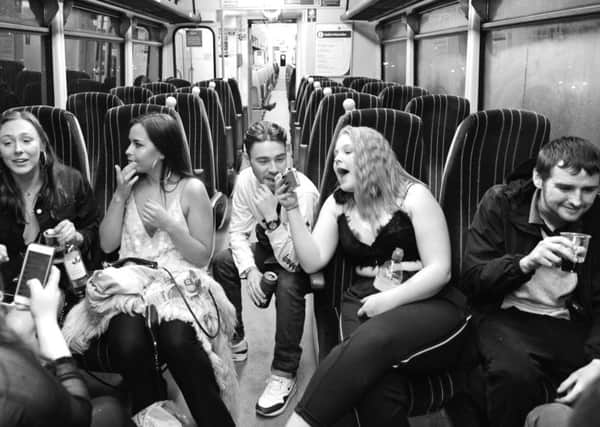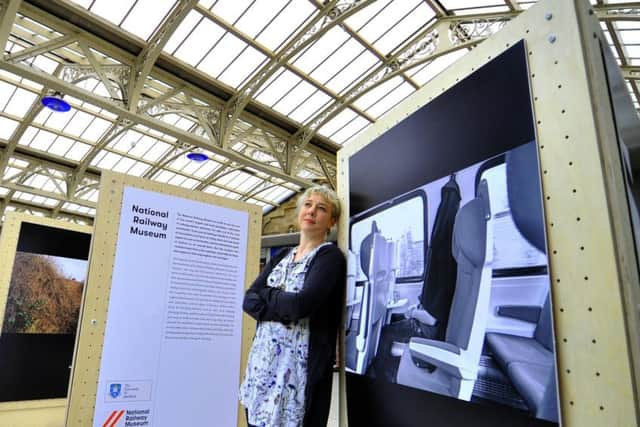A snapshot of life on Yorkshire's railways


Railways have been an integral part of British life ever since the Industrial Revolution. Now a major new project conceived and carried out in Yorkshire has used them to explore the way life and culture in this country has changed in the past 200 years.
The Railway Cultures collaboration between researchers at the University of Sheffield and the National Railway Museum in York has already inspired a two-day conference, two books and two exhibitions, with some of the work currently on display at Sheffield railway station.
Advertisement
Hide AdAdvertisement
Hide AdIt works from a simple premise – the idea of approaching the railways not just as another form of transportation but as a cultural force that has both reflected and shaped life in the UK for more than two centuries.


Work in the exhibition includes a new piece by artist and writer Simon Bill produced using the colours of King Edward VII’s Royal Carriage and a series of paintings depicting British railways in 1950s, 60s, and 1970s that were made by Peter Bartle, a signalman and self-taught artist from Rotherham, who died in 2006.
But day-to-day life on modern railways has also been explored through a series of photographs capturing contemporary railway users taken by Sheffield-based artist Laura Page, while another fascinating element of the project looking at Yorkshire’s more recent history involved artist Andrew Conroy walking the region’s abandoned colliery lines to take pictures.
Page says she took around 15 journeys through Yorkshire, Derbyshire and Merseyside to capture the varied experiences of rail passengers.
Advertisement
Hide AdAdvertisement
Hide AdShe worked with Dr Komarine Romdenh Romluc from the university’s Department of Philosophy on her element of the project.
“I spent a lot of time travelling around on random trains often chatting with people and telling them what I was doing until they forgot I was there so I could photograph candidly, capturing a natural scene.
“Some people made their train journeys an enjoyable part of their trip, sharing a drink on the way to a night out or having a chat with friends. Others tried to just continue getting on with the jobs they had to do, working on their laptops or eating their lunch while some tried to block the journey out having a sleep before reaching their destination.”
She adds: “I worked with Dr Romdenh Romluc who does a lot of fascinating work around perception. We looked at how the space in a train is shaped to accommodate certain activities and actions and how the behaviours that shape human environments, like the train, include those that are dictated by cultural norms – we regulate our behaviour, such as how close we stand to someone else, how we sit and eat, and so on, in a way that is considered socially acceptable.
Advertisement
Hide AdAdvertisement
Hide Ad“We also try to adapt the environment further to aid our own needs so we might, for example, use a hook to hang a coat from to make a small tent to block out the light so we can sleep – all of which can be seen in my images in the exhibition.”
Dr Amanda Crawley Jackson from the university’s School of Languages and Cultures, helped oversee the project and accompanied Andrew Conroy on his colliery line walks, which she says were a hugely educational about the loss of industries once at the heart of the region’s economy.
“It is a massive part of Yorkshire’s history,” she says. “But they are often slipping through behind new housing estates or running alongside retail parks and are pretty much unseen but they are amazing spaces with lots of nature and very peaceful.
“But they are also like this living museum of Yorkshire in the 1970s. We saw graffiti saying ‘Scargill’ and ‘Tories Out’. You really felt you were walking through history.”
Advertisement
Hide AdAdvertisement
Hide AdShe says the wider scheme has an ambitious purpose. “Railways are a hugely important part of life and culture in modern day Britain. The first passenger railway was built in the UK and railways were an integral part of Britain’s role in the Industrial Revolution. However, fast forward nearly 200 years and railways are still very much an important part of many people’s lives in the UK today.
“Railways take people to work, they take people on holiday and they connect people with their loved ones. They may seem like just another mode of transportation, but they actually contain lots of stories that illustrate life and culture in modern day Britain.
“The artwork featured in the Railway Cultures Exhibition provides a glimpse into everyday life on Britain’s railways, but they also give us a unique perspective of how life and culture in Britain has changed over the past 200 years.”
The project came about as an extension of work done by Dr Oliver Betts, a research fellow at the National Railway Museum, exploring the link between country houses and the railways that he had been assisted with by Sheffield University.
Advertisement
Hide AdAdvertisement
Hide AdHe says he is thrilled at how the scheme has developed, with the work on display to the thousands of people who pass through Sheffield railway station each day.
“It has grown and grown and this is the latest iteration. The idea of displaying things about the railways at railway stations has a 200-year history so it is really great to be doing this outreach.”
Results from the collaboration also include a book, Railway Cultures, which features artworks and short essays about the collections held in the National Railway Museum’s archives and life on the railways today.
Students and staff from the University of Sheffield have also been commissioned to write short stories and poems on the theme of railways for a creative writing journal – Route 57: Loco-Motion – that will be published alongside the project.
Advertisement
Hide AdAdvertisement
Hide AdResults from the collaboration were shared at a two-day conference at the National Railway Museum in April where researchers from UK universities met with delegates from the heritage industry and cultural sector. The conference further explored how museums and universities can work together to support urban regeneration and communities.
The collection of artwork is on display at Sheffield Railway Station following a launch event at DLA Piper in the city. Ed Bartholomew, senior curator at the National Railway Museum, says the idea could potentially be extended to other stations, with the museum having thousands of fascinating paintings and posters in its archives.
“Only a small percentage is on display to the public, partly because of the vulnerability of the posters,” he says. We have got some of the best works on display and we are always looking for new ways to display them, it is really important we do that.”
Museum gears up for holiday events
The National Railway Museum has a series of special events running for families over the half-term holidays next week.
Advertisement
Hide AdAdvertisement
Hide AdThe museum in York has free entry for families, with highlights between May 26 and June 4 including the chance to experiment with magnetic-powered travel, imagining how to build the railway of tomorrow and discovering more than 200 years of history in a new way with the centre’s new Treasure Hunters app.
The engineering hub offers the chance to chat to real railway engineers, while it is also possible to go on steam rides.
The activities are part of the musuem’s support for the Year of Engineering — a Government campaign celebrating the world and wonder of engineering.